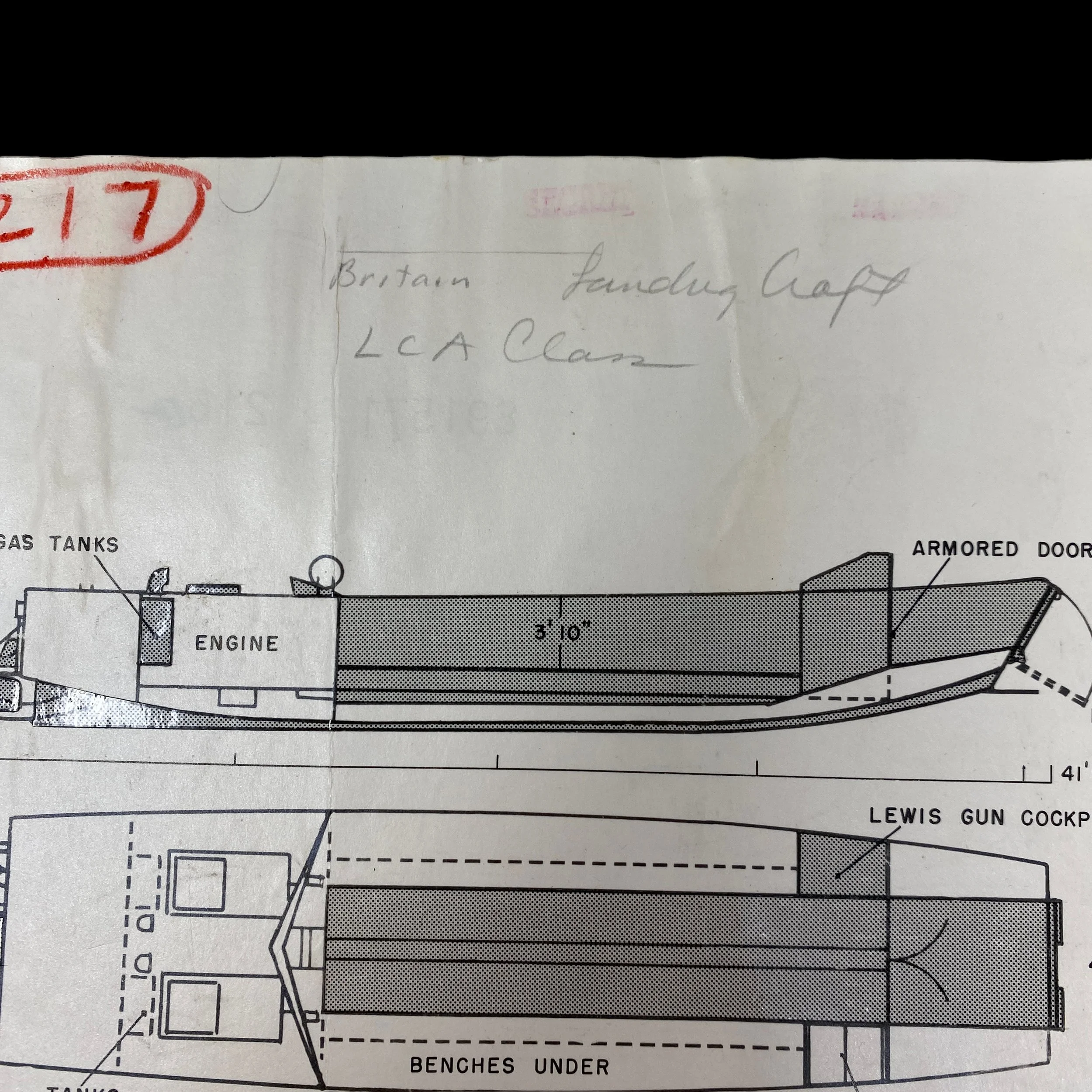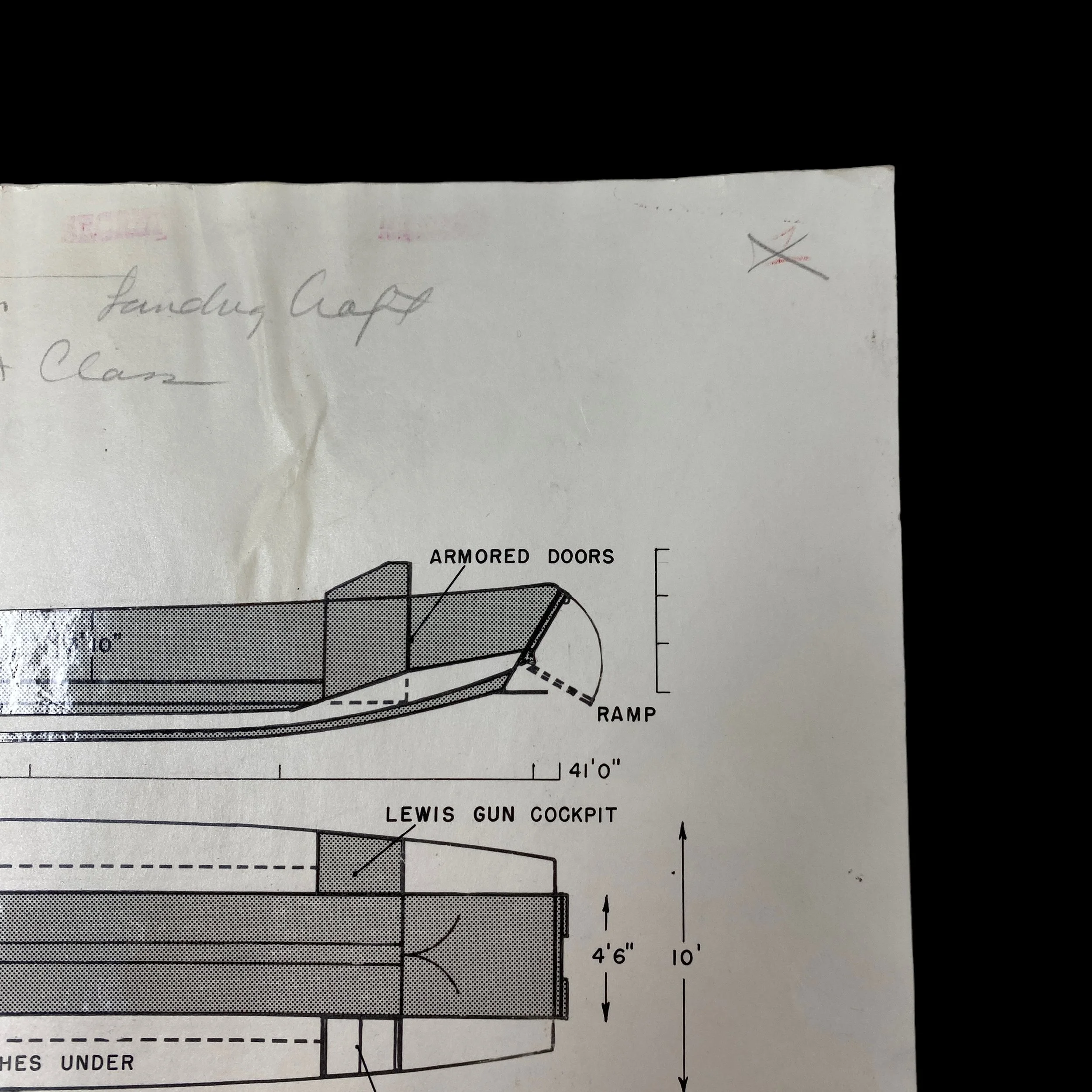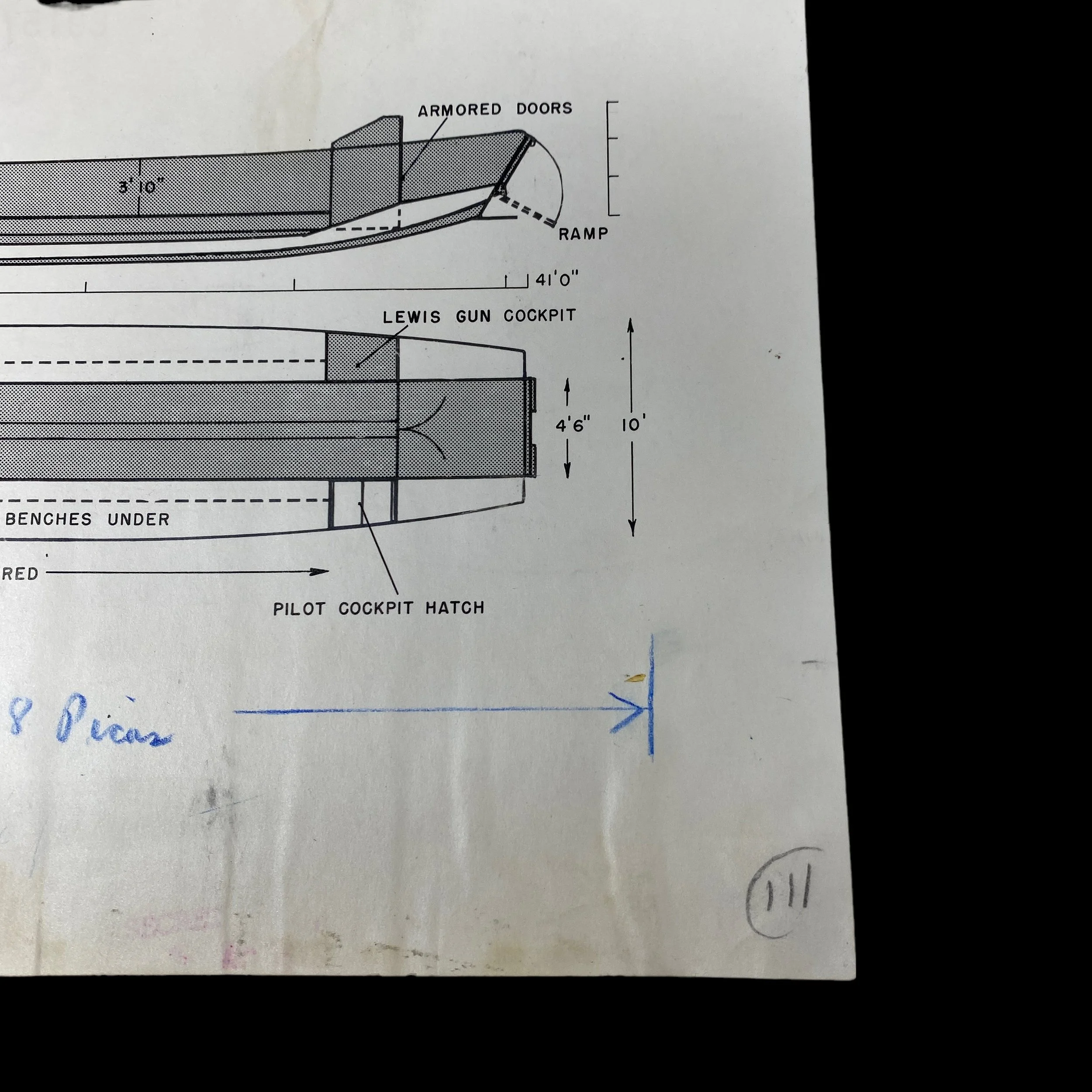RARE! Original SECRET WWII Normandy D-Day Landing Craft Assault Design Blueprint














RARE! Original SECRET WWII Normandy D-Day Landing Craft Assault Design Blueprint
Comes with hand-signed C.O.A. and a full historical write-up
This incredibly rare and museum-grade original WWII Landing Craft Assault blueprint diagram was used during the design, constriction, and repair of the LCA/Landing Craft Assault during World War II. This rare working blueprint features many hand-marking and revisions that were done during the initial design process. Marked SECRET this blueprint is an incredible piece of WWII and D-Day history.
Normandy Landings (D-Day): On June 6, 1944, LCAs were used extensively in the Allied invasion of Normandy. They ferried troops from larger transport ships to the beaches of Normandy under heavy fire. The LCAs' ability to quickly unload troops and equipment was crucial in establishing a foothold on the continent.
The Allied Landing Craft, Assault (LCA) played a crucial role during World War II, particularly in the amphibious operations of the Allies. These small, versatile vessels were instrumental in the success of numerous beach landings, and their contribution cannot be overstated.
1. History and Development
The history of the Allied LCA dates back to the pre-war years, as military planners recognized the need for specialized landing craft to facilitate amphibious assaults. The initial idea was to create a vessel that could transport infantry and equipment directly to the shore under fire, a concept that would prove invaluable in the impending conflict. The need for such a craft became evident with the increasing possibility of large-scale amphibious operations, such as the Normandy landings and the Pacific Island-hopping campaigns.
The development of the LCA was a joint effort involving several Allied nations, including the United States, the United Kingdom, and Canada. The Royal Navy took the lead in designing and producing these vessels. The first prototype of the LCA, known as the LCA Mk.1, was developed in 1938. It was designed to be a shallow-draft, unarmored landing craft capable of carrying up to 35 fully equipped troops or an equivalent cargo load. Subsequent models, including the LCA Mk.2 and Mk.3, incorporated improvements based on operational experience.
2. Design and Characteristics
The Allied LCA was a simple yet robust vessel, purpose-built for amphibious warfare. Some of its key design features and characteristics included:
Shallow Draft: LCAs were designed to operate in shallow waters, allowing them to approach beaches with varying depths. This feature was crucial for landing troops and equipment close to the shore, reducing the time they would be exposed to enemy fire.
Open Bow Ramp: The LCA featured a distinctive open bow ramp that could be lowered to create a ramp for troops and equipment to disembark quickly. This design allowed for rapid and efficient unloading during beach landings.
Compact Size: LCAs were relatively small and lightweight, making them easy to transport and maneuver. They could be carried on larger ships, such as Landing Ship, Tank (LST), and Landing Ship, Infantry (LSI), to transport them to the intended landing site.
Crew and Capacity: The typical crew of an LCA consisted of three to four sailors, including a coxswain and crew members responsible for operating the boat. The LCA had a carrying capacity of around 35 troops or an equivalent cargo load.
Speed and Maneuverability: LCAs were equipped with powerful engines, which gave them a decent top speed of around 8-10 knots. This speed, combined with their maneuverability, allowed them to swiftly navigate through congested waters and make precise landings.
Armament: While the primary focus of the LCA was transportation, some variants were armed with light machine guns or other small arms for self-defense.
3. Operational Significance
The Allied LCA played a pivotal role in many critical amphibious operations during World War II. It was an integral component in the success of the following key campaigns:
Normandy Landings (D-Day): On June 6, 1944, LCAs were used extensively in the Allied invasion of Normandy. They ferried troops from larger transport ships to the beaches of Normandy under heavy fire. The LCAs' ability to quickly unload troops and equipment was crucial in establishing a foothold on the continent.
Pacific Island-hopping Campaign: Throughout the Pacific theater, Allied forces used LCAs to launch assaults on Japanese-held islands. These craft allowed for rapid landings on beaches and played a crucial role in securing strategically important locations.
Mediterranean Campaign: The Mediterranean saw numerous amphibious operations during the war. LCAs were utilized in landing operations in North Africa, Italy, and the Aegean Islands, where they facilitated the rapid deployment of troops and equipment.
Burma Campaign: In the dense jungles and challenging terrain of Burma, LCAs were employed to move troops and supplies along the many rivers and waterways, contributing to the success of Allied forces in the region.
Northwest Europe Campaign: Beyond D-Day, LCAs continued to be used in operations in Northwest Europe, including river crossings and further amphibious landings in France, Belgium, and the Netherlands.
4. Legacy and Impact
The Allied LCA left an enduring legacy and had a profound impact on the outcome of World War II. Their contribution to the success of amphibious operations cannot be overstated. These versatile and agile craft allowed Allied forces to bypass heavily fortified defenses, gain a foothold on enemy-held shores, and secure victory.
Moreover, the lessons learned from the design and use of LCAs during World War II influenced the development of subsequent landing craft and amphibious warfare doctrine. The concept of the open bow ramp, for instance, became a standard feature in later landing craft, such as the Landing Craft, Mechanized (LCM) and Landing Craft, Utility (LCU).
In conclusion, the Allied LCA was an essential component of the Allies' strategy during World War II. Its design and operational significance allowed for the successful execution of numerous amphibious operations, which played a pivotal role in the defeat of Axis forces. The legacy of the LCA lives on in modern amphibious operations, as its design and operational principles continue to influence the development of landing craft and tactics used by military forces around the world.